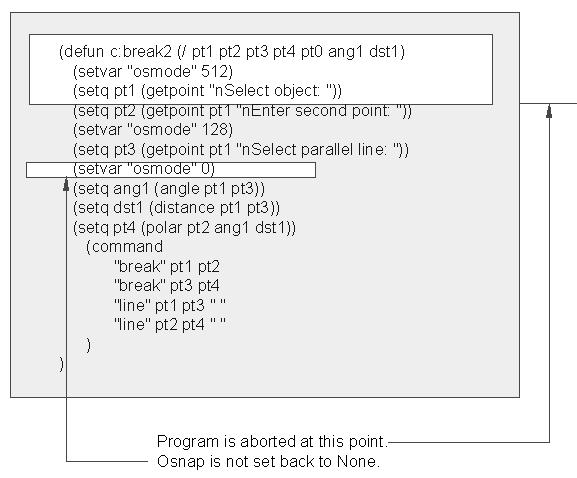
- •Introduction
- •Who should read this book
- •How This Book Is Organized
- •How to Use This Book
- •Where to Find the LISP Programs
- •CHAPTER 1: Introducing AutoLISP
- •Understanding the Interpreter and Evaluation
- •The Components of an Expression
- •Using Arguments and Expressions
- •Using Variables
- •Understanding Data Types
- •Integers and Real Numbers
- •Strings
- •Lists
- •File Descriptors
- •Object Names
- •Selection Sets
- •Symbols
- •Subrs
- •Atoms
- •Assigning Values to Variables with Setq
- •Preventing Evaluation of Arguments
- •Applying Variables
- •Functions for Assigning Values to Variables
- •Adding Prompts
- •CHAPTER 2: Storing and Running Programs
- •Creating an AutoLISP Program
- •What you Need
- •Creating an AutoLISP File
- •Loading an AutoLISP file
- •Running a Loaded Program
- •Understanding How a Program Works
- •Using AutoCAD Commands in AutoLISP
- •How to Create a Program
- •Local and Global Variables
- •Automatic Loading of Programs
- •Managing Large Acad.lsp files
- •Using AutoLISP in a Menu
- •Using Script Files
- •CHAPTER 3: Organizing a Program
- •Looking at a Programs Design
- •Outlining Your Programming Project
- •Using Functions
- •Adding a Function
- •Reusing Functions
- •Creating an 3D Box program
- •Creating a 3D Wedge Program
- •Making Your Code More Readable
- •Using Prettyprint
- •Using Comments
- •Using Capitals and Lower Case Letters
- •Dynamic Scoping
- •CHAPTER 4: Interacting with the Drawing Editor
- •A Sample Program Using Getdist
- •How to Get Angle Values
- •Using Getangle and Getorient
- •How to Get Text Input
- •Using Getstring
- •Using Getkword
- •How to Get Numeric Values
- •Using Getreal and Getint
- •How to Control User Input
- •Using Initget
- •Prompting for Dissimilar Variable Types
- •Using Multiple Keywords
- •How to Select Groups of Objects
- •Using Ssget
- •A Sample Program Using Ssget
- •CHAPTER 5: Making Decisions with AutoLISP
- •Making Decisions
- •How to Test for Conditions
- •Using the If function
- •How to Make Several Expressions Act like One
- •How to Test Multiple Conditions
- •Using the Cond function
- •How to Repeat parts of a Program
- •Using the While Function
- •Using the Repeat Function
- •Using Test Expressions
- •CHAPTER 6: Working With Geometry
- •How to find Angles and Distances
- •Understanding the Angle, Distance, and Polar Functions
- •Using Trigonometry to Solve a Problem
- •Gathering Information
- •Finding Points Using Trigonometry
- •Functions Useful in Geometric Transformations
- •Trans
- •Atan
- •Inters
- •CHAPTER 7: Working with Text
- •Working With String Data Types
- •Searching for Strings
- •Converting a Number to a String
- •How to read ASCII text files
- •Using a File Import Program
- •Writing ASCII Files to Disk
- •Using a Text Export Program
- •CHAPTER 8: Interacting with AutoLISP
- •Reading and Writing to the Screen
- •Reading the Cursor Dynamically
- •Writing Text to the Status and Menu Areas
- •Calling Menus from AutoLISP
- •Drawing Temporary Images on the Drawing Area
- •Using Defaults in a Program
- •Adding Default Responses to your Program
- •Dealing with Aborted Functions
- •Using the *error* Function
- •Organizing Code to Reduce Errors
- •Debugging Programs
- •Common Programming Errors
- •Using Variables as Debugging Tools
- •CHAPTER 9: Using Lists to store data
- •Getting Data from a List
- •Using Simple Lists for Data Storage
- •Evaluating Data from an Entire List at Once
- •Using Complex Lists to Store Data
- •Using Lists for Comparisons
- •Locating Elements in a List
- •Searching Through Lists
- •Finding the Properties of AutoCAD Objects
- •Using Selection Sets and Object Names
- •Understanding the structure of Property Lists
- •Changing the properties of AutoCAD objects
- •Getting an Object Name and Coordinate Together
- •CHAPTER 10: Editing AutoCAD objects
- •Editing Multiple objects
- •Improving Processing Speed
- •Using Cmdecho to Speed up Your Program
- •Improving Speed Through Direct Database Access
- •Filtering Objects for Specific Properties
- •Filtering a Selection Set
- •Selecting Objects Based on Properties
- •Accessing AutoCAD's System Tables
- •CHAPTER 11: Accessing Complex Objects
- •Accessing Polyline Vertices
- •Defining a New Polyline
- •Drawing the new Polyline
- •Testing for Polyline Types
- •How Arcs are Described in Polylines
- •Accessing Object Handles and Block Attributes
- •Using Object Handles
- •Using Object Handles
- •Extracting Attribute Data
- •Appendix A: Menu Primer
- •Appendix B: Error Messages
- •Appendix C: Group Codes
The ABC’s of AutoLISP by George Omura
The C:SEQ program still requires the two conditional expressions that were added earlier:
(if (not *seqpt)(setq *seqpt 2.0))
.
.
.
(if (not spc)(setq spc *seqpt)(setq *seqpt spc)) ;set global
But without increasing the amount of code, we are able to make a simpler and more flexible system to add prompts to our programs. An added benefit is a more readable program.
Dealing with Aborted Functions
If you are writing programs for yourself, you may not be too concerned with how the program looks or behaves. But if you start to write programs for others to use, you have to start thinking about ways of making your programs more error proof. You should provide ways of easily exiting your program without creating problems for the unfamiliar user. Error handling, as it is often called, is writing your program to include code that anticipates any possible input errors the user might come up with. Fortunately, most of AutoLISPs get functions have some error handling capabilities built in. If you enter a string when a get function expects a point, you will get a message telling you that a point is expected.
But the most common error handling problem you will encounter is the aborted program. We can get an idea of how an aborted program can affect a users work by using the C:BREAK2 program from chapter 6.
Open an AutoCAD file and load the C:BREAK2 program. Start C:BREAK2 by entering break2 at the command prompt. At the prompt:
Select object:
press the Ctrl-C key combination to abort the program. Now any time you use your cursor to select a point or object, you will get the "nearest" osnap override. This because you aborted the program before it was able to set the osnap mode back to none (see figure 8.14).
179
Copyright © 2001 George Omura,,World rights reserved

The ABC’s of AutoLISP by George Omura
Figure 8.14: What happens when C:BREAK2 is aborted
Using the *error* Function
To deal with problems like this, you can use a special AutoLISP function called *error*. If a function is created using *error* as its name, it is evaluated whenever an error occurs. Figure 8.15 shows the Break2.lsp file with the addition if an *error* function. Open the Break2.lsp file and add the *error* function shown in figure 8.16.
180
Copyright © 2001 George Omura,,World rights reserved

The ABC’s of AutoLISP by George Omura
(defun *error* (msg) (setvar "osmode" 0) (princ msg)
(princ)
)
(defun c:break2 (/ pt1 pt2 pt3 pt4 pt0 ang1 dst1) |
|
(setvar "osmode" 512) |
;near osnap mode |
(setq pt1 (getpoint "\nSelect object: ")) |
;get first break point |
(setq pt2 (getpoint pt1 "\nEnter second point: ")) |
;get second break point |
(setvar "osmode" 128) |
;perpend osnap mode |
(Setq pt3 (getpoint pt1 "\nSelect parallel line: "));get 2nd line |
|
(Setvar "osmode" 0) |
;no osnap mode |
(setq ang1 (angle pt1 pt3)) |
;find angle btwn lines |
(setq dst1 (distance pt1 pt3)) |
;find dist. btwn lines |
(setq pt4 (polar pt2 ang1 dst1)) |
;derive pt4 on 2nd line |
(command |
|
"break" pt1 pt2 |
;break 1st line |
"break" pt3 pt4 |
;break 2nd line |
"line" pt1 pt3 "" |
;close ends of lines |
"line" pt2 pt4 "" |
|
) |
|
) |
|
|
|
Figure 8.15: The Break2.lsp file with an error checking function added.
Save the file go back to the AutoCAD file. Be sure that osnap is set to "none". Load and start the C:Break2 program. Again, at the Select object prompt, enter a Ctrl-C.
Now, instead of leaving the osnap mode in the "nearest" setting, the *error* function returns the osnap setting back to "none". It also prints the message:
Function cancelled
Lets look at this function to see exactly how it works. The first line looks like a typical defun expression:
(defun *error* (msg)
The argument list contains the symbol msg. *error* accepts as an argument, an error message. This error message is the one that appears normally without the *error* function. In the next line:
(setvar "osmode" 0)
181
Copyright © 2001 George Omura,,World rights reserved

The ABC’s of AutoLISP by George Omura
the osnap mode is set back to 0. Next, the error message supplied by AutoLISP is printed to the AutoCAD prompt:
(princ msg)
The last princ prevents the error message from appearing twice in the prompt.
This works very nicely assuming that you always have osnap set to "none". But suppose your osnap setting varies during your editing session and you want your function to return to whatever the current setting is at the time a program is issued. Figure 6.16 shows the Break2 program again with some additional code that helps restore the osnap setting to its previous setting regardless of what it may have been.
(defun *error* (msg) (setvar "osmode" *osnap) (princ msg)
(princ)
)
(defun c:break2 (/ pt1 pt2 pt3 pt4 pt0 ang1 dst1) |
|
(setq *osnap (getvar "osmode")) |
|
(setvar "osmode" 512) |
;near osnap mode |
(setq pt1 (getpoint "\nSelect object: ")) |
;get first break point |
(setq pt2 (getpoint pt1 "\nEnter second point: ")) |
;get second break point |
(setvar "osmode" 128) |
;perpend osnap mode |
(Setq pt3 (getpoint pt1 "\nSelect parallel line: "));get 2nd line |
|
(Setvar "osmode" *osnap) |
;no osnap mode |
(setq ang1 (angle pt1 pt3)) |
;find angle btwn lines |
(setq dst1 (distance pt1 pt3)) |
;find dist. btwn lines |
(setq pt4 (polar pt2 ang1 dst1)) |
;derive pt4 on 2nd line |
(command |
|
"break" pt1 pt2 |
;break 1st line |
"break" pt3 pt4 |
;break 2nd line |
"line" pt1 pt3 "" |
;close ends of lines |
"line" pt2 pt4 "" |
|
) |
|
) |
|
Figure 8.16: The C:BREAK2 program modified to handle any osnap setting
The line:
(setq *osnap (getvar "osmode"))
is added to the beginning of the program. This creates a global variable *osnap which holds the osnap code that determines the current osnap setting. The expression that returns the osnap mode to "none":
182
Copyright © 2001 George Omura,,World rights reserved
